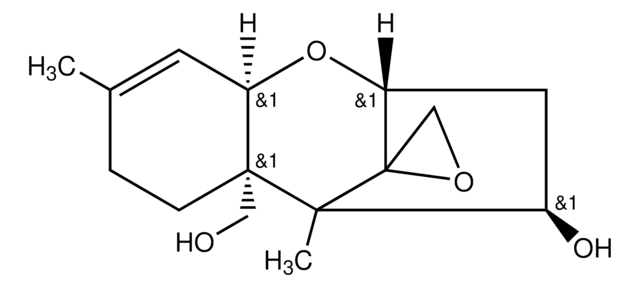V4877
Verrucarin A from Myrothecium sp.
≥85.0% (HPLC)
Synonym(s):
Muconomycin A
About This Item
Recommended Products
Quality Level
assay
≥85.0% (HPLC)
storage temp.
−20°C
SMILES string
CC1CCOC(=O)\C=C\C=C\C(=O)OC2CC3OC4C=C(C)CCC4(COC(=O)C1O)C2(C)C35CO5
InChI
1S/C27H34O9/c1-16-8-10-26-14-33-24(31)23(30)17(2)9-11-32-21(28)6-4-5-7-22(29)36-18-13-20(35-19(26)12-16)27(15-34-27)25(18,26)3/h4-7,12,17-20,23,30H,8-11,13-15H2,1-3H3/b6-4+,7-5+
InChI key
NLUGUZJQJYVUHS-YDFGWWAZSA-N
General description
Application
- as a translation initiation inhibitor in P. falciparum W2 strain
- as a peptidyl transfer inhibitor to test sensitivity in methyltransferase knock-out S. cerevisiae cells
- to test its cytotoxicity in renal cell carcinoma cells
Biochem/physiol Actions
Other Notes
signalword
Danger
hcodes
Hazard Classifications
Acute Tox. 1 Inhalation - Acute Tox. 2 Dermal - Acute Tox. 2 Oral
Storage Class
6.1A - Combustible acute toxic Cat. 1 and 2 / very toxic hazardous materials
wgk_germany
WGK 3
ppe
Eyeshields, Faceshields, Gloves, type P3 (EN 143) respirator cartridges
Certificates of Analysis (COA)
Search for Certificates of Analysis (COA) by entering the products Lot/Batch Number. Lot and Batch Numbers can be found on a product’s label following the words ‘Lot’ or ‘Batch’.
Already Own This Product?
Find documentation for the products that you have recently purchased in the Document Library.
Customers Also Viewed
Our team of scientists has experience in all areas of research including Life Science, Material Science, Chemical Synthesis, Chromatography, Analytical and many others.
Contact Technical Service










